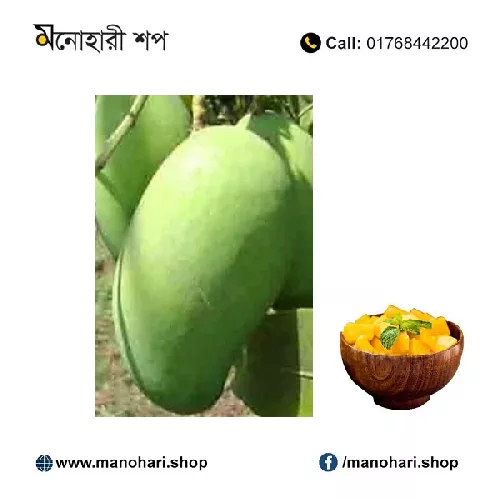Mango is the most cash crop of the tropical areas of the world. The scientific name of the Mango is
"MAGNIFERA INDICA”. This fruit is being farming for more than a thousand years in various places of the world. The Mango origins from the Indo-Burma area and Bangladesh also located in the same territory.
Bangladeshi Mango is very famous and delicious. Mango is farmed on more than fifty thousand hectares of land in Bangladesh. The mango took place as a cash crop and it is highly demandable at home and abroad due to its delicious test. There are many kinds of products manufactured from green and ripe mango like mango juice, dry green mango, different kinds of mango pickles,s, etc. All kinds of mango products are very delicious, have attractive flavors, and have very high nutritional value. The mango is called as a king of fruit in the South East Asian region. Mango contains a high percentage of vita carotene, vitamin C, sugar, and another mineral. The human body easily accepts mango and improve the antibody to protect the diseases which cause due to shortage of nutrition.
The mango research station has been established at Chapai Nowabgonj, Bangladesh in 1985. This is the first research station in Bangladesh. Rajshahi and Chapai nowabgonj is called mango growing area. There are 1500 types of mango have been found in the world and Bangladesh has 500 (Approx) types. Good breeds of mango are named as Fozli, Rani pasand, Gopal Vog, khirshapat (himshagor), langra, Amrapali, gouramoti, Darbhanga etc. Late variety mango “ashshina” also become very testy due to the fruit bagging system. “Jhinuk ashshina” is one of the varieties of Ashshina mangoes and named by Mr. Md. Anwarul Houe (Convener, Rajshahi Agrofood producer society) which is very testy and demandable. The GI (geographical Identity) of Khirshapat mango from Chapai nowabgonl will be declared very soon.
Dr. Sharfuddin, SSO, Chapai Nowabgonj Mango Research Center implemented the mango bagging
system in Bangladesh. He is also awarded Bangabandhu National Agriculture Award 2017. Dr. Akram H Chowdhury, Chairman BMDA encouraged Mango Farmers to implement a GAP system to produce good quality mango. Bangladesh is exporting mango to the EU and Gulf territories since 2015.
From 2016-2017
Bangladesh followed the GAP system (Fruit Bagging System) to grow good quality mango but export was not up to the mark.
Mango Season & Weight
Rajshahi Mango harvesting season starts in May and ends in September. As per the verity the
harvesting season starts:
Serial No. Name of Mango Harvesting start Harvesting finish Weight
1 Gopalvog 25th May 10th June 200 gm to 250 gm
2 Khirshapat 1st June 30th June 250 gm to 350 gm
3 Langra 7th June 7th July 300 gm to 350 gm
4 10th July 200 gm to 300 gm
5 Laksmanvog 10 June 20th July 500 gm to 800 gm
6 Fozli 20th June 31st July 200 gm to 250 gm
25th June
Amrapali
-----------------------Page 1 End-----------------------
Now a day to protect the mango from “hopper insects” and other effects, insecticide and pesticide
sprayed for 3 / 4 times and mango bagging starts in the 2nd week of April. After 45 to 60 days later mango
removed from the bag to get a healthy and insecticide-free mango. Rajshahi Agrofood Producer Society is
working relentlessly to produce insecticide and pesticide-free mango for domestic and international
markets. The yearly turnover of 2016 & 2017 was 1 million USD per year and the current year export
target is 10 million USD. Bangladesh has already been declared a developed country by the UN and mango
export plays a significant role to earn foreign currency. Bangladesh already earned a good name in the export market by exporting readymade garments, tea, lather & lather product, ceramic, mango,
vegetable, etc.

No comments:
Post a Comment